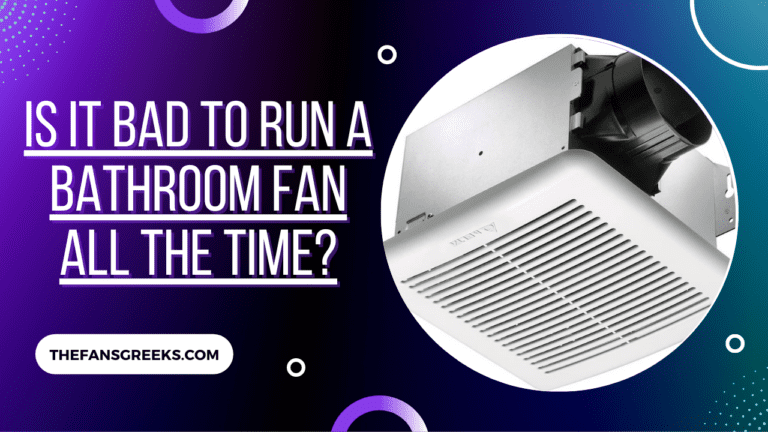What Are Bathroom Fan Sones?
The importance of proper bathroom ventilation cannot be overstated. The presence of too much moisture in your bathroom can result in mold spores that can damage your home structurally and cause rot.
In order to prevent all those problems, ensure your bathroom is properly ventilated and get a bathroom fan that suits your needs. While not being too loud, it must be powerful enough to accomplish the job.
In order to understand different noise levels, you need to know what bathroom fan sones are, what they measure, and why they are important. Find out more by reading on.
What Are Sones?
Almost all household appliances make some noise – your fridge, dishwasher, laundry washer, TV, etc. It’s the same with your bathroom fan.
If you want your bathroom to be your oasis of peace and quiet, having a reasonably quiet bathroom fan is very important. This is why you should aim for a low fan sone score.
Sound is measured by a sone, which is the average listener’s perception of it. In contrast to decibels, which measure sound pressure levels, loudness is a subjective measure.
Furthermore, unlike decibels, sones grow exponentially. Therefore, four sones are twice as loud as two sones, and four sones are twice as loud as a single sone, and so on.
What Are Sone Levels?
Make sure the “sone levels” of a new bathroom fan are correct.
In a silent room, one sone is equivalent to the amount of noise a refrigerator makes while quietly humming. Additionally, two sones would equal the noise that two refrigerators would create, etc.
In other words, a typical office space has a noise level of two sones, while a normal conversation has a volume of three stones.
Since this unit grows exponentially, five sones are as loud as a restaurant during peak hours, while most people put their TVs on four. Lastly, loud people during a sports match at a stadium or arena make approximately six tones of noise.
Since bathroom fans can be as quiet as 0.3 sones or as loud as six sones, this is all you need to know.
What Does Sone Rating Mean for a Bathroom Fan?
Just now, you read about the difference between decibels and sones. We, humans, use decibels to measure physical sound, but there is more to it than that. Sound perception is equally dependent on pitch and frequency as it is on any other factor.
We perceive lower frequencies as quieter than high frequencies. In terms of a rating, a low sone rating means that a fan is softer to us, whereas a high sone rating is something that you should avoid.
The quietest bathroom fan is one that scores between 0.3 and 1 scones. Unless you are highly sensitive to noise, it is not advisable to pursue the lowest possible score, which is about as loud as leaves rustling on the ground.
In general, everything below three sones is considered average. The bathroom fan can be considered loud if it scores four sones or more.
Older fans tend to be louder, while modern fans can go up to three tones.
You can Also read Best Bathroom Exhaust Fans With LED Lights
Should You Care About Bathroom Fan Sones?
If you are not too sensitive to noise, there is no need to purchase an extremely quiet bathroom fan.
In some cases, two-sone fans are ten times less expensive than those with a 0.3-sones rating. A higher rating simply means that you’ll be able to tell when your fan is on in real life. Through closed doors, you probably won’t even be able to hear a fan this loud.
In a bathroom of 70 square feet or less, an average fan with a 2.0 rating will work well.
A fan that makes very little or no noise is another situation where you should pay attention to the loudness level. Old and quiet fans are most likely broken. You can test this by putting a piece of toilet paper close to the fan. Congratulation – your fan still works if the paper sticks to it.
CFM and Sones – A Relation You Should Know About
A bathroom fan shouldn’t just be quiet – it should also be powerful. This is where another crucial unit of measure comes into play. Using cubic feet per minute measurements, you can determine how quickly your fan moves, and one hundred cubic feet of air can be moved in one minute by a 100 CFM fan.
A fan rated at 50 CFM would suffice for a smaller bathroom, while an average bathroom requires a fan rated at 75-100 CFM.
Your bathroom fan will be too loud if the CFM is too high, whereas its ventilation will be inadequate if the CFM is too low.
As a general rule, CFM should match your bathroom’s square footage. Taking a nine-foot by five-foot bathroom as an example, you will need a fan with a CFM score of 45 or higher.
You should also consider the height of your ceiling if it is exceptionally high. You will need a more robust fan since there is more vertical space. After you calculate the square footage of your bathroom, add 50 CFM if it is particularly large – greater than one hundred feet.
Alternately, you can add 50 CFM to each appliance – bathtubs, toilets, and showers. 100 CFM will be needed for a hot tub.
Don’t manipulate numbers by getting a fan with a low CFM just to get a lower rating
You can also have a look at Most Expensive Ceiling Fans With Light
Ways To Soundproof Your Bathroom
At the market, you can find fans that run at a slower speed. Although this will reduce the noise level, the fan will also become less effective. However, this doesn’t mean you can’t vent your bathroom exhaust to make it quieter.
It is advisable to put materials that absorb sound in your bathroom to make it less noisy.
For example, The floor of your bathroom could be covered with cork flooring tiles. Your bathroom’s moisture and humidity won’t harm these, which will reduce noise levels.
It is also possible to install a sound-blocking door sweep. For better insulation and soundproofing, you should also seal the bathroom door with weather stripping.
Consider installing a low-flow toilet if you are bothered by the noise. This will make less noise and be more eco-friendly than a regular one.
To return to the bathroom fans – if a quiet bathroom is your top priority, keep the fan on a separate switch so it doesn’t automatically turn on when the light comes on. By doing so, people won’t have to turn on the fan if they don’t want to.
Other Things That Impact the Noise Level of a Bathroom Fan
There are other simple factors that influence the amount of noise a bathroom fan makes. You can find them here.
A fan with a larger venting will be quieter. Furthermore, a flush-mounted fan makes less noise than one that is angled. Last but not least, screw fittings are quieter than nails.
Care and Maintenance
Maintaining your bathroom fan and making sure it works properly is not difficult.
You should keep your fan clean and dust-free to keep it running smoothly. You should clean your faceplate every now and then with warm soapy water and a toothbrush. Clean the fan interior as well after removing the faceplate.
To prolong the life of the fan, turn it off when not in use.
There could be something wrong with your fan if it suddenly becomes noisy. A slow start or strange noises might also be signs that something is wrong with it.
As an appliance, a bathroom fan is prone to wear and tear. A malfunctioning bathroom fan could pose a safety hazard. It’s time to retire that old fan and replace it with a new one – and ideally, one that’s quieter.

![Bathroom Fan Stopped Working (Won’t Turn On) [FIXED]](https://www.thefansgreeks.com/wp-content/uploads/2022/08/Bathroom-Fan-Stopped-Working-Wont-Turn-On-FIXED-768x432.png)
![Cold Air Coming in Through the Bathroom Fan [FIXED]](https://www.thefansgreeks.com/wp-content/uploads/2022/08/Cold-Air-Coming-in-Through-the-Bathroom-Fan-768x432.png)



